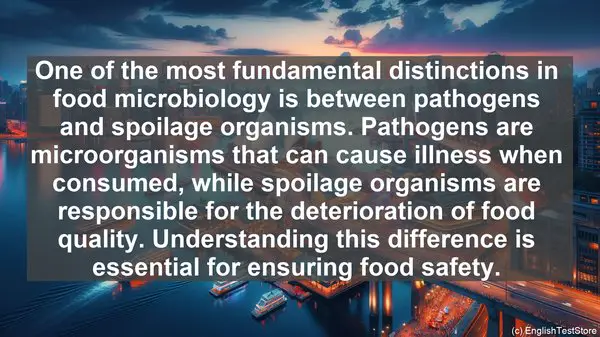Introduction
Welcome to today’s lesson on food microbiology. In this lesson, we’ll be discussing the top 10 commonly confused words in this field. Understanding these words is crucial for a solid foundation in food microbiology. So, let’s dive right in!
1. Pathogen vs. Spoilage Organism
One of the most fundamental distinctions in food microbiology is between pathogens and spoilage organisms. Pathogens are microorganisms that can cause illness when consumed, while spoilage organisms are responsible for the deterioration of food quality. Understanding this difference is essential for ensuring food safety.

2. Sterilization vs. Pasteurization
Sterilization and pasteurization are both methods used to control microbial growth in food. However, they differ in intensity. Sterilization eliminates all microorganisms, including spores, while pasteurization reduces the microbial load, making the food safer without completely eliminating all microorganisms.
3. Antimicrobial vs. Antibiotic
While these terms are often used interchangeably, there is a distinction. Antimicrobial refers to any substance that can inhibit the growth of microorganisms, including bacteria, viruses, and fungi. Antibiotics, on the other hand, specifically target bacteria. So, all antibiotics are antimicrobials, but not all antimicrobials are antibiotics.
4. Fermentation vs. Spoilage
Fermentation and spoilage are two different outcomes of microbial activity in food. Fermentation is a controlled process that involves the conversion of sugars into other compounds, such as alcohol or acids, by microorganisms. Spoilage, on the other hand, refers to the undesirable changes in food quality due to microbial activity, leading to off-flavors, odors, or texture changes.
5. Indicator Organism vs. Pathogen
Indicator organisms are used as a measure of overall hygiene and sanitation in food processing. They are not necessarily harmful themselves, but their presence indicates the potential for pathogenic microorganisms. Pathogens, on the other hand, are the actual disease-causing microorganisms that can pose a risk to human health.
6. Cross-Contamination vs. Cross-Contact
These terms are often used in the context of food safety. Cross-contamination refers to the transfer of harmful microorganisms from one surface or food to another, potentially leading to contamination. Cross-contact, on the other hand, refers to the transfer of allergens from one food to another, potentially causing an allergic reaction in susceptible individuals.

7. Shelf-Life vs. Expiration Date
Shelf-life refers to the period during which a food product retains its quality, including taste, texture, and nutritional value. The expiration date, on the other hand, is the date after which the product is no longer considered safe to consume. It’s important to understand and adhere to both to ensure food safety and quality.
8. Prebiotic vs. Probiotic
Prebiotics and probiotics are both beneficial to gut health, but they differ in their nature. Prebiotics are non-digestible fibers that serve as food for beneficial gut bacteria, promoting their growth. Probiotics, on the other hand, are live microorganisms that, when consumed in adequate amounts, confer health benefits to the host.
9. HACCP vs. GMP
HACCP (Hazard Analysis and Critical Control Points) and GMP (Good Manufacturing Practices) are both systems used in the food industry to ensure safety. HACCP focuses on identifying and controlling specific hazards at critical points, while GMP encompasses broader practices to ensure overall quality and safety throughout the manufacturing process.
10. Biodegradable vs. Compostable
These terms are often used in the context of food packaging. Biodegradable refers to materials that can break down naturally over time, but the process might not always be environmentally friendly. Compostable materials, on the other hand, not only break down but also contribute to nutrient-rich compost, benefiting the environment.
